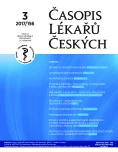Hidradenitis suppurativa – symptoms, diagnostics, and therapy
Authors:
Monika Arenbergerová; Robert Artur Dahmen; Petr Arenberger
Authors‘ workplace:
Dermatovenerologická klinika 3. LF UK a FNKV, Praha
Published in:
Čas. Lék. čes. 2017; 156: 127-132
Category:
Review Article
Overview
Hidradenitis suppurativa is a chronic skin disorder characterized by recurrent inflammatory nodules, fistulas, abscesses, and scarring mainly in the intertriginous areas with terminal hair and apocrine glands. Hidradenitis suppurativa manifests usually after puberty, in the third life decade and persists for many years. The prevalence of the disease is estimated to be 0,5 % in the Czech Republic. Women are most often affected in the axillary and inguinal parts, while men in the perianal and gluteal areas.
The exact pathogenesis is still unknown. It is assumed that hyperkeratosis of the hair follicle leads to its occlusion, dilatation and further rupture when keratin and bacteria are spilled into the dermis causing a massive inflammatory reaction. Smoking and obesity belong to the main triggering factors.
Without therapy, the disease is chronic and progressive. The standard therapy depends on the extension of the disorder. For not extensive lesions, treatment consists of topical antiseptics, antibiotics or long- term therapy with systemic antibiotics. In more advanced stages, systemic therapy with TNF-α antagonists is needed. Further therapeutic modality is surgical intervention and wide excision of the affected area. Nevertheless, recurrences in the adjacent tissue cannot be avoided.
Keywords:
hidradenitis suppurativa, acne inversa, therapy, adalimumab
Sources
1. Plewig G, Steger M. Acne inversa (alias acne triad, acne tetrade or hidradenitis suppurativa). In: Marks R, Plewig G (eds.): Acne and Related Disorders. Martin Dunitz, London, 1989: 345–357.
2. Hidradenitis Suppurativa Foundation, 7895 via Belfiore, San Diego, California 92129, www.hs.foundation.org
3. Zouboulis CC, Desai N, Emtestam L et al. European S1 guideline for the treatment of hidradenitis suppurativa/acne inversa. J Eur Acad Dermatol Venereol 2015; 29: 619–644.
4. Jemec G, Heidenheim M, Nielsen NH et al. The prevalence of hidradenitis suppurativa and its potential precursor lesions. J Am Acad Dermatol 1996; 35: 191–194.
5. Fitzsimmons JS, Guilbert PR. A family study of hidradenitis suppurativa. J Med Genet 1985; 22: 367–373.
6. Kurzen H, Kurokawa I, Jemec GB et al. What causes hidradenitis suppurativa? Exp Dermatol 2008; 17: 455–456.
7. Rödder-Wehrmann O, Küster W, Plewig G et al. Acne inversa. Diagnosis and therapy. Hautarzt 1991; 42: 5–8.
8. Highet AS, Warren RE, Staughton RC et al. Streptococcus milleri causing treatable infection in perineal hidradenitis suppurativa. Br J Dermatol 1980; 103: 375–381.
9. Machet L, Samimi M, Delage M et al. Systematic review of the efficacy and adverse events associated with infliximab treatment of hidradenitis suppurativa in patients with coexistent inflammatory diseases. J Am Acad Dermatol 2013; 69: 649–650.
10. Porter ML, Kimball AB et al. Comorbidities of hidradenitis suppurativa. Semin Cutan Med Surg 2017; 36: 55–57.
11. Yuan JT, Naik HB et al. Complications of hidradenitis suppurativa. Semin Cutan Med Surg 2017; 36: 79–85.
12. Tsianos EV, Dalekos GN, Tzermias C et al. Hidradenitis suppurativa in Crohn’s disease. A further support to this association. J Clin Gastroenterol 1995; 20: 151–153.
13. Jemec GB, Wendelboe P. Topical clindamycin versus systemic tetracycline in the treatment of hidradenitis suppurativa. J Am Acad Dermatol 1998; 39: 971–974.
14. Gulliver W, Zouboulis CC, Prens E et al. Evidence-based approach to the treatment of hidradenitis suppurativa/acne inversa, based on the European guidelines for hidradenitis suppurativa. Rev Endocr Metab Disord 2016; 17: 343–351.
15. Kimball AB, Okun MM, Williams DA et al. Two phase 3 trials of adalimumab for hidradenitis suppurativa. N Engl J Med 2016; 375: 422–434.
16. DeFazio MV, Economides JM, King KS et al. Outcomes after combined radical resection and targeted biologic therapy for the management of recalcitrant hidradenitis suppurativa. Ann Plast Surg 2016; 77: 217–222.
Labels
Addictology Allergology and clinical immunology Angiology Audiology Clinical biochemistry Dermatology & STDs Paediatric gastroenterology Paediatric surgery Paediatric cardiology Paediatric neurology Paediatric ENT Paediatric psychiatry Paediatric rheumatology Diabetology Pharmacy Vascular surgery Pain management Dental HygienistArticle was published in
Journal of Czech Physicians

- Metamizole at a Glance and in Practice – Effective Non-Opioid Analgesic for All Ages
- Metamizole vs. Tramadol in Postoperative Analgesia
- Advances in the Treatment of Myasthenia Gravis on the Horizon
- Spasmolytic Effect of Metamizole
- What Effect Can Be Expected from Limosilactobacillus reuteri in Mucositis and Peri-Implantitis?
Most read in this issue
- Basal cell carcinoma and the modalities of its therapy
- Diseases affecting the scalp
- Hirsutism – etiopathogenesis, diagnostics and treatment
- Androgenetic alopecia in women
